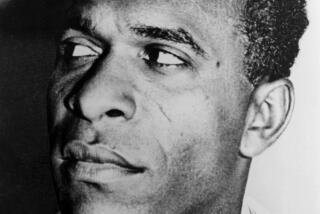Jean-Michel Folon, 71; Renowned Commercial Artist Used Surrealistic Style to Depict Humanistic Themes
Jean-Michel Folon, an architectural school dropout whose surrealistic and witty watercolors often tackled serious, humanistic themes and turned him into one of the worldâs best-known commercial artists, has died. He was 71.
Folon died Thursday in a Monaco hospital after a long illness, said Lieven De Buck, director of Guy Pieters Gallery in Saint-Paul-de-Vence, France, which had worked with Folon for three decades.
The versatile artist was a painter, cartoonist and sculptor whose work appeared throughout the world in galleries and magazines and on murals in subway stations. His muted watercolors featured serpentine arrows, blank-faced men and pedestrian-dwarfing buildings, as well as rainbows, birds and boats.
âThe talent of Jean-Michel Folon was as large as his heart,â French President Jacques Chirac said in a statement.
He called Folon, who was a friend, âan inspired poet who, for more than half a century, enlightened us with his colors.â
Among the themes that ran through Folonâs work were the alienation of modern man in the face of techno-culture, the spectacle in the small gestures of everyday life, and the magical power of imagination.
His most familiar figure was an Everyman, an anonymous urban man in hat and raincoat who popped up against often overwhelming backgrounds in his paintings.
Folon designed the birds-in-flight logo for the bicentennial of the French Revolution in 1989, posters for Amnesty International and UNICEF campaigns, and stamps for Britain that honored the Red Cross and United Nations. He also decorated sets for operas, produced short movies and became known for film animation.
The son of a Brussels paper wholesaler, Folon was born March 1, 1934. He regarded Belgium during his childhood as a boring âmental prison,â and art became his escape. His parents forced him to study architecture, but when he turned 21 in 1955, he packed a small bag of art supplies and left for Paris six months before getting his degree.
His first big break came when the artistic director of Olivetti commissioned him to create advertising posters for typewriters and illustrations for handbooks. Later, he did covers for Time and the New Yorker magazines, often showing empty, canyon-like streets of skyscrapers drawn with few strokes.
These caricatures of modern urbanism were âmy revenge on what I had been taught in architecture school,â he once said.
He cited Swiss painter Paul Klee and New Yorker illustrator and cartoonist Saul Steinberg as influences, but his style was regarded as his own.
âI do not have any historical importance. I have invented nothing, because I owe so much to everyone,â Folon wrote to a friend in 1990.
âI have only tried to depict my own dreams with the hope that in them others may hang their own.â
Folon is survived by his wife and a son from his first marriage.
More to Read
The biggest entertainment stories
Get our big stories about Hollywood, film, television, music, arts, culture and more right in your inbox as soon as they publish.
You may occasionally receive promotional content from the Los Angeles Times.











